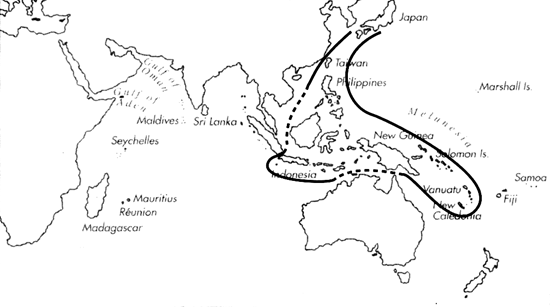
Skip Navigation Links
View access keys for this site.

Range: Japan to Indonesia, Papua New Guinea, Solomon Is., New Caledonia, and Vanuatu.
Description: Moderately small to medium-sized, moderately light to moderately solid. Last whorl narrowly conoid-cylindrical, conoid-cylindrical or ventricosely conical; outline convex adapically, less so or straight below. Aperture wider at base than near shoulder. Shoulder subangulate or rounded. Spire of low to moderate height, outline deeply concave to straight or slightly sigrnoid. Larval shell of about 2.25 whorls, maximum diameter about 0.8 mm. Teleoconch sutural ramps flat to convex, with 1 increasing to 3-5 spiral grooves, usually weaker on late ramps and sometimes visible only on early ramps; spiral sculpture dominated by a strong subsutural groove. Basal fourth to half of last whorl with widely spaced axially striate spiral grooves and flat ribbons between; basal grooves wider and often with a spiral thread.
| Shell Morphometry | ||
|---|---|---|
| L | 30-57 mm | |
| RW | 0.06-0.30 g/mm | |
| RD | 0.47-0.60 | |
| PMD | 0.75-0.86 | |
| RSH | 0.09-0.20 | |
Colour light violet to greenish grey or shading from beige to orange or blackish brown; sometimes with tan and olive spiral bands. Last whorl with spiral rows of orange to dark brown and pale ground-colour dots and dashes; rows highly variable in number, sometimes absent, with alternating dark and light markings or all light or all dark markings. Dark shells either immaculate or with additional spirally aligned white or grey flecks; light shells with additional spirally aligned orangish to dark brown markings. Larval whorls ranging from pale to dark brown. Early postnuclear sutural ramps immaculate, often similar in colour to larval shell. Later sutural ramps immaculate, or with dark axial markings, or with scattered white spots in very dark shells; sometimes outer margins with regularly set orange to brown dots. Aperture white, bluish white or violet behind a translucent outer margin and an adjacent narrow orange or brown zone.
Periostracum thin, translucent, and smooth.
Dorsum of foot with a beige median zone spotted with black and dotted with white, numerous spots and dots and 2 large tan latero- frontal blotches anteriorly; lateral submarginal zones white, variably maculated with black, and solid black posteriorly; margins beige, grading to tan in posterior third. Sole white to tan. Rostrum dark brown. Tentacles beige. Siphon white, mottled with various shades of brown; mottling sparse on ventral side and absent from tip (Hansa Bay, Papua New Guinea; Chaberman, pers. comm., 1981).
Habitat and Habits: Upper subtidal. In Philippines, egg diameter of 521 µm predicts benthic development (Perron & Kohn, 1985).
Discussion: <C. cinereus resembles C. lienardi, C. parius, C. radiatus, and C. oishii. C. lienardi differs in its rather angulate shoulder, complete or reduced reticulate pattern on last whorl and spire, and in the absence of any spirally aligned dots and dashes; its early postnuclear whorls are tuberculate. C. parius can be distinguished by its uniformly light coloured shells with an opaque periostracum; its aperture lacks an orange to brown collabral zone. C. radiatus differs from C. cinereus in its usually larger size (to 109 mm), usually lower spire (RSH 0.05-0.11), less regular spiral sculpture of the last whorl and in more and stronger spiral grooves on the late sutural ramps. For comparison with C. oishii, see the Discussion of the latter species. C. cinereus is a polytypic species, and variability may be high within populations; this has led to a number of synonyms: - C. caerulescens and C. exaratus refer to subadult specimens, which have spiral grooves from base to shoulder. - C. bernardii (Pl. 18, Figs. 9, 12) is a reddish brown colour variant with spirally arrayed grey or white markings at shoulder, within adapical third and near centre. It occurs sympatrically with the typical form in Philippines and Indonesia. - C. politus refers to a blackish brown form with hieroglyphic-shaped white markings on the last whorl, occurring in Philippines. - C. gubba (Pl. 18, Figs. 14,15) was described as having a uniformly blackish brown adult shell, and a juvenile shell with white flecks. It seems to be restricted to Manus Id., Papua New Guinea. It cannot be separated from C. cinereus by shape or sculpture of the shell but its distinctive colouration and limited distribution may justify subspecies status. Shells from Java have a broader last whorl than those from other localities.

C. cinereus range map
This section contains verbatim reproductions of the accounts of 316 species of Conus from the Indo-Pacific region, from Manual of the Living Conidae, by Röckel, Korn and Kohn (1995). They are reproduced with the kind permission of the present publisher, Conchbooks.
All plates and figures referred to in the text are also in Röckel, Korn & Kohn, 1995. Manual of the Living Conidae Vol. 1: Indo-Pacific Region.
The range maps have been modified so that each species account has it own map, rather than one map that showed the ranges of several species in the original work. This was necessary because each species account is on a separate page on the website and not confined to the order of accounts in the book.
Return to framed version (returns to search page)